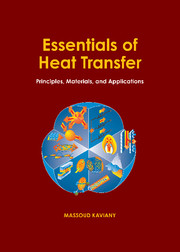Book contents
- Frontmatter
- Contents
- Preface
- Acknowledgments
- Guide to Instructors and Students
- 1 Introduction and Preliminaries
- 2 Energy Equation
- 3 Conduction
- 4 Radiation
- 5 Convection: Unbounded Fluid Streams
- 6 Convection: Semi-Bounded Fluid Streams
- 7 Convection: Bounded Fluid Streams
- 8 Heat Transfer in Thermal Systems
- Nomenclature
- Glossary
- Answers to Problems
- Appendix A Some Thermodynamic Relations
- Appendix B Derivation of Differential-Volume Energy Equation
- Appendix C Tables of Thermochemical and Thermophysical Properties
- Subject Index
5 - Convection: Unbounded Fluid Streams
Published online by Cambridge University Press: 05 June 2012
- Frontmatter
- Contents
- Preface
- Acknowledgments
- Guide to Instructors and Students
- 1 Introduction and Preliminaries
- 2 Energy Equation
- 3 Conduction
- 4 Radiation
- 5 Convection: Unbounded Fluid Streams
- 6 Convection: Semi-Bounded Fluid Streams
- 7 Convection: Bounded Fluid Streams
- 8 Heat Transfer in Thermal Systems
- Nomenclature
- Glossary
- Answers to Problems
- Appendix A Some Thermodynamic Relations
- Appendix B Derivation of Differential-Volume Energy Equation
- Appendix C Tables of Thermochemical and Thermophysical Properties
- Subject Index
Summary
Chapter Five can be found on the text Web site www.cambridge.org/kaviany. In Chapter 5, we begin discussion of convection heat transfer by considering an unbounded fluid stream undergoing a temperature change along the stream flow direction, where this change is caused by an energy conversion. Convection heat transfer is the transfer of heat from one point to another by a net (i.e., macroscopic) fluid motion (i.e., by currents of gas or liquid particles) given by the fluid velocity vector. The fluid motion can be void of random fluctuations, which is called a laminar flow, or it can have these random fluctuations, which is called a turbulent flow. Convection heat transfer examines themagnitude, direction, and spatial and temporal variations of the convection heat flux vector in a fluid stream. In this chapter, we examine convective heat transfer within a fluid stream without directly considering the heat transfer between the fluid and a bounding solid surface (i.e., here we consider only intramedium conduction and convection of unbounded fluid streams). In addition to the occurrence of the intramedium (i.e., bulk) convection, in many practical applications involving cooling and heating of fluids, the review of the intramedium convection allows for an introductory treatment of laminar, steady-state, uniform, one-directional fluid flow without addressing the effect of the fluid viscosity emanating from the bounding surfaces, which would require inclusion of the momentum conservation equation.
- Type
- Chapter
- Information
- Essentials of Heat TransferPrinciples, Materials, and Applications, pp. 424 - 425Publisher: Cambridge University PressPrint publication year: 2011



